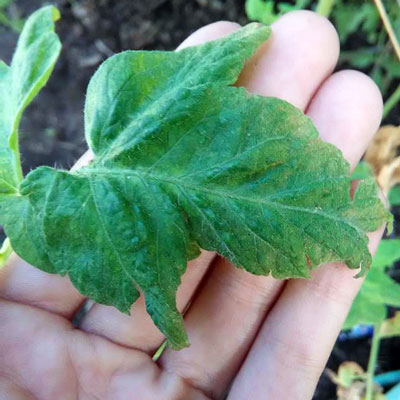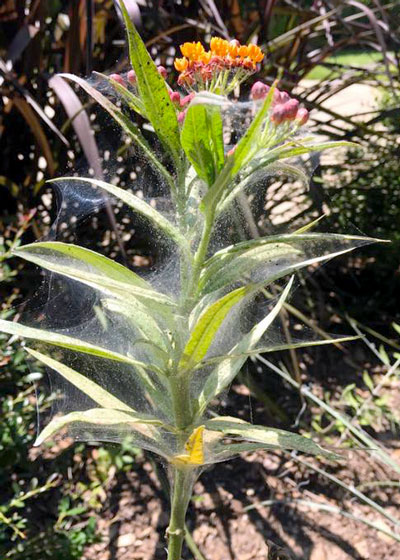Question of the Week Number 2: June 28, 2018
“Neil, what’s attacking my Green Mound junipers? It’s happened really fast.”

Green Mound juniper is being attacked by an outbreak of spider mites. They can quickly kill out the entire planting if no steps are taken.
Spider mites! Nearly microscopic, 8-legged pests that are more closely related to spiders and ticks than they are to insects. They’re so small you could put 20 on the head of a pin. They suck the very life out of a huge variety of landscape and garden plants causing millions of dollars worth of plant losses each year.

Tomato leaf shows early stages of spider mite infestation. Fine mottling is evident. You learn to watch for these symptoms from late May on.
Here are the symptoms…
• Almost always start at the bottoms of infested plants, then work their way up.
• Leaves develop a characteristic tan mottling – tiny, light cream-colored speckles.
• Leaves become almost solid white.
• Leaves begin to turn brown and crisp.
(from this stage on it may be difficult to save infested plants)
• Very fine webbing may be visible in leaf axils (where leaves attach to plant stems).
• Plant dies as mite infestation spreads to adjacent plants.

An incredibly serious outbreak of spider mites on ornamental milkweed. There is probably no saving this plant by this point.
Some of most common host plants…
• Tomatoes,
• Beans,
• Cucumbers and squash,
• Marigolds,
• Junipers,
• Sweet violets
• Crotons
• Ageratums
• Almost any plant is susceptible, however.
Confirming the infestation…
• You can see the mites with low-power magnification.
• Thump a suspect leaf over a sheet of white paper, then watch for tiny specks to start moving about. Don’t be surprised if you see scores of them.
Ways to treat for spider mites…
• Spray both top and bottom leaf surfaces.
• Unfortunately, we no longer have specific miticides available at the consumer level.
• Look for general-purpose insecticides that are labeled for spider mite control. Your local independent retail garden center operator will be able to help you.
• You will probably have to make two or three treatments for full control. Check weekly to monitor mite activity on your plants.
